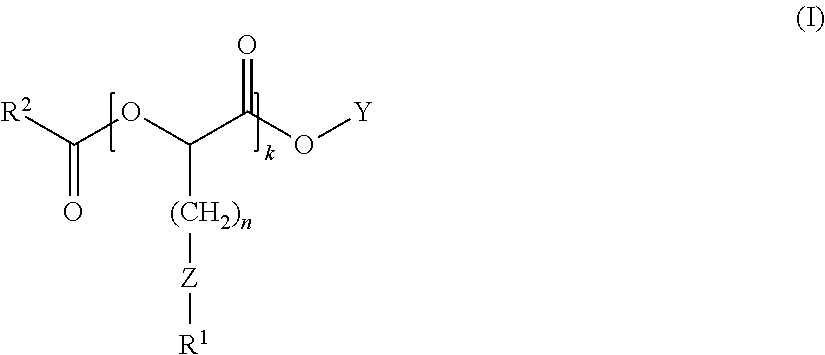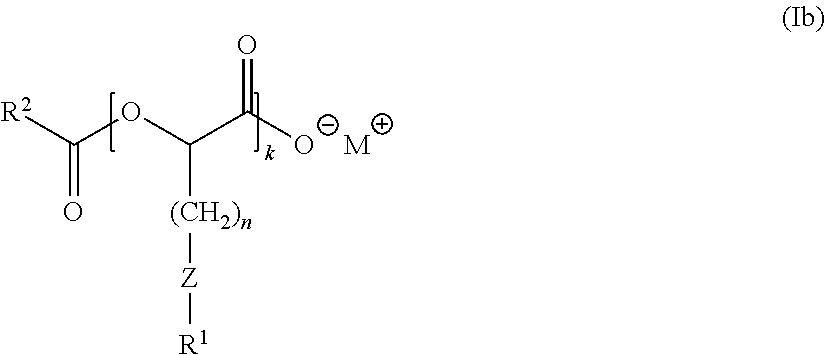Anionic surfactants
a technology of anionic surfactants and surfactants, applied in the field of surfactants, can solve the problems of affecting the hardness tolerance of carboxylate surfactants, the propensity to precipitate, and the reduction in the use of anionic surfactants relative to other anionic surfactants,
- Summary
- Abstract
- Description
- Claims
- Application Information
AI Technical Summary
Benefits of technology
Problems solved by technology
Method used
Image
Examples
example 1
Synthesis of 4-(methylsulfinyl)-2-(palmitoyloxy)butanoic acid (C16ESOCOOH)
Step 1: Synthesis of 4-(methylthio)-2-(palmitoyloxy)butanoic acid
[0151]To 2-hydroxy-4-(methylthio)butanoic acid (10.08 g, 67.1 mmol) in dichloromethane (DCM; 200 mL) at 0° C. was added 4-dimethylaminopyridine (DMAP; cat.), triethylamine (Et3N; 18.7 mL, 134 mmol) followed by palmitoyl chloride (10.2 mL, 33.6 mmol) dropwise over about 1 hour. The reaction was allowed to warm to room temperature with stirring overnight. The solution was concentrated to a small volume and re-dissolved in heptane (300 mL). The organic layer was washed with 1N HCl (3×100 mL), water (2×100 mL) and brine (1×100 mL), then dried over magnesium sulfate, filtered and evaporated to give 14.4 g of a white solid. A portion (7 g) of this solid was purified by silica gel chromatography with 0-25% ethyl acetate (EA) / heptane and 1% acetic acid (AcOH) additive to give a white solid (5.8 g, 45%).
Step 2: Synthesis of 4-(methylsulfinyl)-2-(palmitoyl...
example 2
Synthesis of 4-(methylthio)-2-(dodecanoyloxy)butanoic acid (C12ESCOOH)
Synthesis of 4-(methylthio)-2-(dodecanoyloxy)butanoic acid (C12ESCOOH)
[0153]Prepared in a similar manner as C16ESCOOH described in step 1 of Example 1, except lauroyl chloride was used as the acylating agent, to give a white solid (1.22 g, 11%). 1H NMR (500 MHz, DMSO-d6) δ ppm 0.85 (3H) 1.16-1.32 (16H) 1.52 (2H) 1.93-2.02 (2H) 2.04 (3H) 2.34 (2H) 2.53 (2H) 4.90-4.97 (1H) 13.11 (1H). m / z 355 (MNa+)
example 3
Synthesis of 4-(methylsulfinyl)-2-(dodecanoyloxy)butanoic acid (C12ESOCOOH)
Step 1: Synthesis of methyl 2-hydroxy-4-(methylsulfinyl)butanoate
[0154]To a solution of methyl 2-hydroxy-4-(methylthio)butanoate (5.10 g, 31.1 mmol) in DCM (150 mL) at 0° C. was added meta-chloroperoxybenzoic acid (m-CPBA; 77%, 6.90 g, 30.8 mmol) portion-wise over 30 min. The resulting mixture was allowed to warm to room temperature with stirring for two days. The mixture was treated with water (100 mL), stirred overnight, and filtered. The filtrate was extracted with water (2×100 mL, 3×50 mL) and the combined aqueous layers were evaporated to give an oil. The oil dissolved in EA was dried over magnesium sulfate, filtered and evaporated. Purification by silica gel chromatography with 0-7% methanol / DCM followed by elution through a Si-Carbonate resin column with methanol gave a colorless oil (4.29 g, 77%).
Step 2: Synthesis of 2-hydroxy-4-(methylsulfinyl)butanoic acid
[0155]A solution of methyl 2-hydroxy-4-(meth...
PUM
| Property | Measurement | Unit |
|---|---|---|
| temperature | aaaaa | aaaaa |
| temperature | aaaaa | aaaaa |
| surface tensions | aaaaa | aaaaa |
Abstract
Description
Claims
Application Information
 Login to View More
Login to View More - R&D
- Intellectual Property
- Life Sciences
- Materials
- Tech Scout
- Unparalleled Data Quality
- Higher Quality Content
- 60% Fewer Hallucinations
Browse by: Latest US Patents, China's latest patents, Technical Efficacy Thesaurus, Application Domain, Technology Topic, Popular Technical Reports.
© 2025 PatSnap. All rights reserved.Legal|Privacy policy|Modern Slavery Act Transparency Statement|Sitemap|About US| Contact US: help@patsnap.com



